One of the most important pieces of equipment we needed to decide on for the 2012 Pacific Crest Thru hike was the shelter. Not only does the shelter protect you from the elements, be that sun, rain or even snow, but it also provides an important psychological safe haven. Over the 5-6 months we will be on the trail, we will very rarely be sleeping in beds or even in permanent structures. Our home for those 5-6 months will be our shelter. Although we fully intend to embrace the wilderness and outdoors, sometimes this may feel overwhelming. This is where the protection of a shelter will help put the mind at rest and provide a good nights sleep.
There are a huge variety of shelters available out there. From large and heavy commercial, double skinned tents to ultra light weight tarps that are little more than a single sheet of fabric. When we started looking at what the best option for us would be, we knew that we weren’t quite ready for the minimalist end of the scale quite yet. Although ultra light weight tarps are appealing for their weight and simplicity, they also provide very little home comforts or the psychophysical protection I talked about.
On the other end of the scale you have the standard ‘tent’. These are generally double skinned (With an inner and a fly sheet) come with aluminium poles and a whole lot of features. They are as close to a home as you will get in the wilderness (Besides actually making a log cabin!) They also tend to weight a lot for the amount of space they provide.
We needed something in the middle of the scale for protection and weight. This generally means single skin shelters. They suffer more from condensation and potentially insects, but save a lot of weight over a twin skin shelter. Initially, the best option looked like a MSR Twin Sisters shelter. This is a off commercial single skin shelter with a relatively low weight of 1474g. Unfortunately it doesn’t have any bug protection. We also considered the GoLite Shangri-La 2, but once you add the inner bug netting and bathtub floor, the weight soon added up.
We then turned out attention to the smaller ‘cottage’ manufacturers. These are small, often one man companies that make specialist equipment for niche markets. One such company is Mountain Laurel Designs in USA. They make very high quality, light weight backpacking equipment. One of their shelters stood out as meeting most of our requirements; The MLD Supermid. This is a fairly large (comfortably sleeps 2 adults, could fit 4 in an emergency).
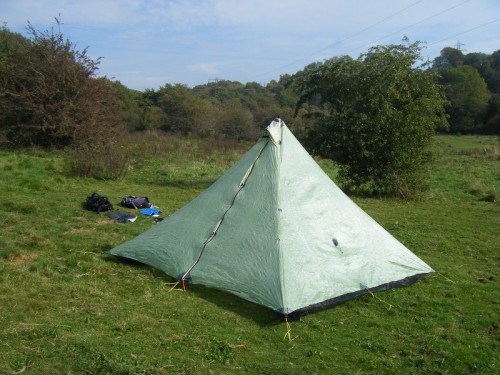
It is very light weight for it’s size, has a simple design that is easy to put up, and the smaller model (the Duomid) has been used extensively for expeditions to places like Alaska, so it has proved that it can stand up to long term use in hard conditions. MLD make most of their shelters out of Silnylon, which is silicone impregnated nylon that makes it waterproof. They also offer the option of making their shelters out of Cuben Fibre. Cuben Fibre is ultra lightweight but super strong fabric, originally designed for racing yacht sails. It is totally waterproof and doesn’t stretch like Silnylon can. Because of the lower weight, this is the option we went for. The final weight for this very durable and large shelter is an impressive 482g.
As a Cuben Fibre Supermid is custom order, it too a while for MLD to make and ship it. Once it was finished I had it shipped to BearPaw Wilderness Designs for a few modifications. One of the features that we wanted that the Supermid doesn’t come with is bug netting. We did consider a separate internal bug net, but this would add a fair amount of weight. One custom design on the BearPaw Wilderness Designs website provided the solution; a perimeter bug net with a bug net door.
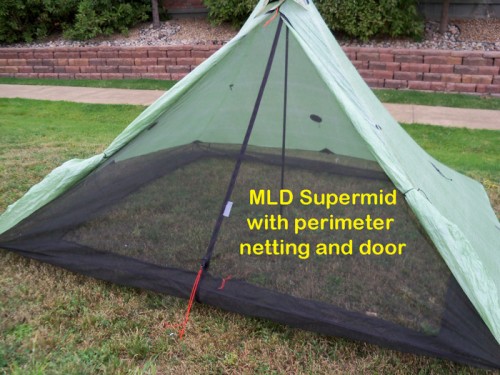
Image courtesy of BearPaw Wilderness Designs.
This design means that the Supermid can be pitched low to the ground or higher up to allow increased ventilation while still offering protection against bugs. Being a perimeter net it minimises the weight while offering the same amount of protection that a full internal net would.
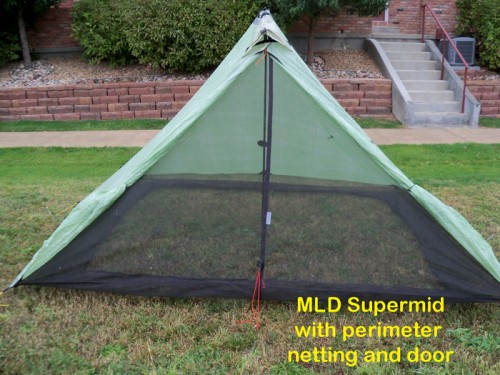
Image courtesy of BearPaw Wilderness Designs.
The bug netting door means that the Supermid door can be rolled back to allow even more ventilation. It also means that we should be able to admire the view while being protected against mosquitoes and bugs.
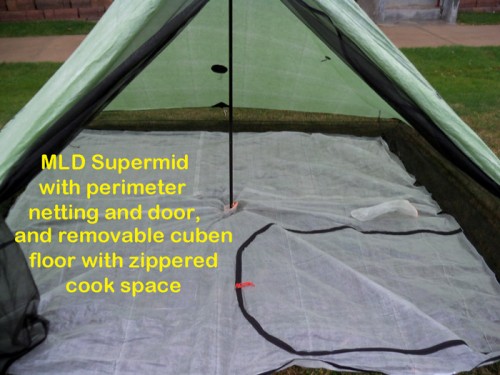
Image courtesy of BearPaw Wilderness Designs.
A final feature that BearPaw Wilderness Designs added was the Cuben Fibre bathtub floor. This floor has a pocket for the centre pole and attaches to the perimeter bug net via a Velcro strip around the edge. We also had a zippered cooking space added to the floor. Although unlikely to be used, it means that if we are stuck inside the shelter in really bad weather, we can unzip a quarter of the floor to reveal bare ground to set the stove up. The zippered area could also be used to store muddy shoes on if was raining badly (although there is some space between the net door and Supermid main door).

One of the benefits of the pyramid design shelters, and the supermid is that it can use trekking poles as the tent pole. As we will already be carrying trekking poles, it means the additional shelter weight is greatly reduced. We will be bringing Mountain King Expedition Carbon trekking poles that are light weight but very strong.
As the Supermid is a fairly large shelter, the poles needs to be longer than the maximum length of a single trekking pole. To overcome this, some people use a ‘pole jack’ that is essentially a metal pole that the trekking pole site on to add some height. Although not as heavy as bringing a totally separate pole, it does add some weight. Another option is to join two trekking poles together. This can be done with a tubular webbing and velcro straps.
A much more elegant option though was provided by www.backpackinglight.co.uk;
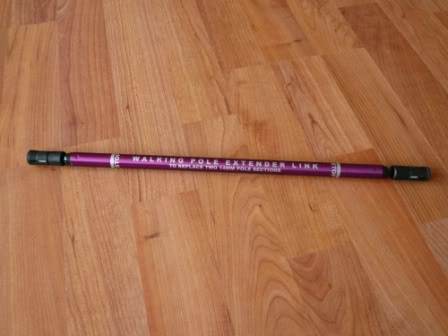
The Walking Pole Extender is essentially a straight section of walking pole with a trekking pole lock at either end. To use it, you simply unscrew and remove the lower section from two trekking poles, then add the Walking Pole Extender in their place. It provides a very strong and elegant solution to joining two poles together. It also means that the pole handles face both up and down, so there is much less change of the Tungsten Carbide tips slipping and tearing anything! The carbon fibre Walking Pole Extender weighs 36g. As we will already be carrying and using the trekking poles, it means that the total weight for our tent poles is 36g!
To fix the Supermid to the ground (As there is only a single, central pole the shelter is not free standing) we will be using a combination of pegs.
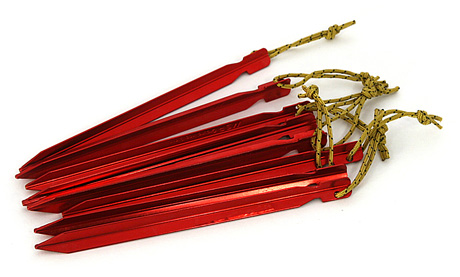
Most of the pegs will be MSR Groundhogs. These are Aluminium Y-Beam pegs that weigh 16g each. They are very strong and being a Y-Beams should hold in softer or sandier ground. Hopefully being bright red, they should be harder to lose.
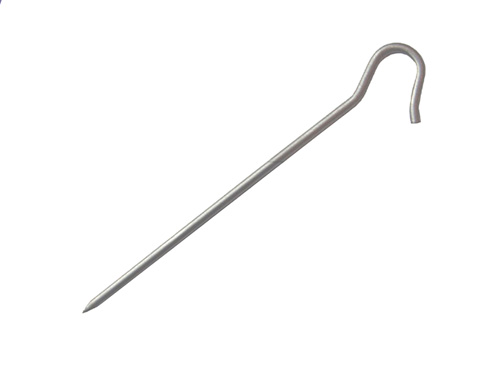
We will also be bringing a few few 2g Titanium Stakes. These small stakes weight only 2 grams each. They should be easier to push into hard ground then the MSR Groundhogs, but also won’t be able to take the same amount of force. The plan is to use Groundhogs on the main tieouts, and the Titanium stakes on the lower load guylines.
I haven’t weighed the Supermid with all the modifications, but I would estimate that they add no more than a few hundred grams. So for a fully bug protected, durable, adaptable and quick to set up shelter, we are looking at;
MLD Supermid; 482g
Bug Netting/Bathtub floor 200g
5x MSR Groundhogs 80g
6x Titanium Stakes 12g
Walking Pole Extender 36g
3x Dyneema Guylines 8g
That it a total of around 818 grams. Not too bad when you compare it to twin skinned commercial tents that can easily weight 3000g or upwards for a similar size. So far we have used it in the Scottish Cairngorms and we were very pleased which is good as this is to be our home for 6 months!
I love your design (SuperMid with custom bug net and bathtub cuben floor) very much and thinking about ordering the same.
What are your impressions after long-term use on PCT?
Hello kirilk,
Yeah, the Supermid was our home for 163 days on the Pacific Crest Trail! We grew to love that as our home. It was our little temple due to the size inside! On the PCT, I think it may have been one of the largest shelters anyone had. But to be honest we wouldn’t really change it apart from a few rare occasions. We never really had any problems finding anywhere to pitch it and the size inside was perfect for the two of us. It allowed us to both have enough space to sleep, get changed and also store all our gear inside on the night. We ended up getting a lot of positive comments from other hikers along the trail who were amazed by the size.
There were a few downsides though; It isn’t free standing so relies entirely on the stakes and centre pole. On a few occasions in the desert, the loose sandy soil simply couldn’t hold the tent stakes well enough to provide a firm fixing (I used MSR groundhogs). Piling rocks on top helped, but it wasn’t ideal. This problem is increased by the size of the supermid as the wind force across such large surface generates a huge amount of pressure. One one occasion this pressure also caused the centre pole to fail (We used 2x Carbon Fibre trekking poles joined together) by simply crushing the lock on the pole. Admittedly this was slightly exceptional as the wind was 50mph gusts from all directions near Walker Pass. So it probably isn’t the ideal shelter is windy conditions are expected. For this I would go with a classic free standing dome tent.
Build quality was good, and fortunately the Cuben Fibre held up better than the Cuben Fibre in our stuff sacks which de-laminated like mad. I would never use Cuben Fibre for items that get a lot of abrasion again. But as a tent material is worked great. It only got some small holes from rubbing against rocks in high wind, but these are easily fixable. Other than that is remained completely waterproof and solid. We did have some problems with the zipper unfortunately. It started not ‘zipping’ the two sides together properly, but on emailing Ron, he sent out a whole new zip, thread, needle and zip lubricant for free which was kind of him. After that the zip worked fine. We had the same problem with the zipper on the bug netting (I think the dust and sand from the start of the trail did the zippers no good!) which unfortunately plagued us for much of the trail. I ended up temporarily fixing it by transplanting one of the zippers from the groundsheet into the door. This worked for a while until that zipper succumbed as well. I would suggest if you do go down this route to ask BearPaw to use a slightly larger, more heavy duty zipper as the one he used on our tent was very small.
Another change I would make as well is to have the perimiter bug netting fixed about 1/2″ to 1″ higher up the inside of the tent wall. Bearpaw fixed it to the very bottom of the wall which meant that water could run down the wall then wick up the netting into the tent. It certainly wasn’t a huge problem, but I feel if it was fixed a tiny bit higher up it would alleviate this problem. Although it would make the set up heavier, I would also see about having the bug netting removable from the tent by means of a velcro strip or similar. This is in-case the netting gets damaged, it could be easily removed and replaced, leaving the expensive Cuben shelter intact.
Other than that, it was all built very well and did the job very well considering the amount of use and abuse it got for 163 continuous days. The only other shelter I would consider is the Laufbursche Lavvu, but I don’t think this is even for sale yet.
Hope this helps a bit. If you have any more questions, please fire away.
Thanks,
Ali
Wow! Many thanks for such detailed report.
Extremely useful information!
I believe your comment deserves to be converted to a post with a couple of pictures.
Hmm, maybe I should go for Silnylon Supermid which is 200 grams heavier, but theoretically should live longer…
By the way, why you have ordered Supermid, not the Luna 4 from Bear Paw Designs (they look very similar)?
Hi there,
I know this is an old tread but really hoping you could tell me if you still have the SuperMid and is it still holding up? Thanks for the writing this blog about the SuperMid it’s be really helpful!
Thank you!
Derek